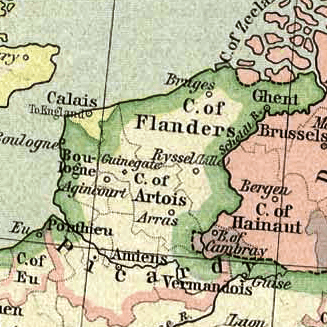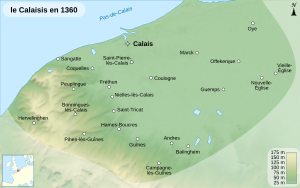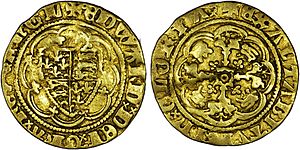Pale of Calais facts for kids
Quick facts for kids
Pale of Calais
|
|||||||||
|---|---|---|---|---|---|---|---|---|---|
| 1347–1558 | |||||||||
|
Motto: Veritas Temporis filia
"Truth, the daughter of Time" |
|||||||||

The Pale of Calais (yellow) in 1477.
|
|||||||||
| Status | Overseas possession of England | ||||||||
| Capital | Calais | ||||||||
| Common languages | English, Dutch, French, Picard | ||||||||
| Religion | Official: Catholic (until 1534) Church of England (from 1534) Others: Judaism |
||||||||
| Lord | |||||||||
|
• 1347–1377
|
Edward III (first) | ||||||||
|
• 1553–1558
|
Mary I (last) | ||||||||
| Governor | |||||||||
|
• 1353
|
Reynold Cobham (first) | ||||||||
|
• 1553–1558
|
Thomas Wentworth (last) | ||||||||
| Historical era | Late Middle Ages | ||||||||
| 3 August 1347 | |||||||||
| 8 May 1360 | |||||||||
| 8 January 1558 | |||||||||
| 2 May 1598 | |||||||||
| Currency | Sterling | ||||||||
|
|||||||||
| Today part of | France | ||||||||
The Pale of Calais was a special area in Northern France. It was ruled by the monarchs of England for over 200 years. This happened from 1347 to 1558. The word "pale" here means a specific area or territory.
England took control of Calais after the Battle of Crécy in 1346. This was followed by a long siege of the city. The English rule was officially agreed upon in the Treaty of Brétigny in 1360.
Calais became a very important place for England. It was a major center for the textile trade in Europe. This trade was mostly about wool and cloth. The city was also a strong military base for England. From here, England could plan and launch attacks on the European continent. Its location on the English Channel made it easy to send supplies and soldiers by sea.
The people living in the Pale of Calais spoke both English and Flemish. This area was even represented in the Parliament of England.
However, during the rule of Mary I, the French took Calais back. This happened after a siege in 1558. After this, England's textile trade moved away from Calais. It went to the Habsburg Netherlands instead.
Geography of the Pale
It is a bit tricky to know the exact size of the Pale of Calais. Its borders changed often. They also included marshy areas and waterways. The land was generally divided into low hills in the west and lower coastlands in the east.
The Pale was roughly the land between Gravelines and Wissant. This area was about 20 square miles (52 square kilometers). Over time, the French kept taking back small parts of the territory. This was especially true for land in the southwest.
Today, the area of the Pale of Calais is part of several French towns. These include Calais, Guînes, and Sangatte.
History of English Rule
Calais was a valuable prize for England. Edward III of England captured it after the Battle of Crécy in 1346. This was after a long siege that lasted almost a year. Taking Calais gave England a key stronghold. It was important for the world's textile trade. It also gave England a strong military base for future wars in Europe.
England's control over Calais was confirmed by the Treaty of Brétigny. This treaty was signed on May 8, 1360. In this agreement, Edward III gave up his claim to the French throne. In return, he received large areas of land, including Aquitaine and the Calais region.
By 1453, the Hundred Years' War ended. The Pale of Calais was the last part of mainland France still held by England. It was a successful base for English military trips. For example, in 1492, King Henry VII launched the Siege of Boulogne from Calais.
The short sea journey across the Strait of Dover made it easy to send soldiers and supplies. However, the area did not have natural defenses inland. This meant England had to spend a lot of money building and keeping up military forts.
For a long time, France and the Duchy of Burgundy were rivals. Both wanted Calais because of its important location. But neither wanted the other to have it. So, they let England keep it. This helped England stay in control for many years.
Later, political situations changed. The land of Burgundy was divided between France and Spain. Also, King Henry VIII faced problems in the Sieges of Boulogne (1544–1546). This made Calais more open to attack from the south. In 1550, England even pulled its troops out of Boulogne.
The Pale of Calais remained part of England until 1558. Then, Queen Mary I unexpectedly lost it to France. French troops, led by Francis, Duke of Guise, secretly prepared. About 30,000 French soldiers attacked the city. Calais quickly surrendered. This was part of the Treaty of Cateau-Cambrésis in 1559.
In England, many blamed Queen Mary for the loss. This made Protestants even more determined against her. Losing Calais was not as bad for England's economy as some feared. However, it was a lasting stain on Mary's reign. The writer Raphael Holinshead said that Mary, on her deathbed, told her family how sad she was. She said, "When I am dead and opened, you shall find ‘Calais’ lying in my heart." After this, the English wool market changed. The textile trade moved to the Habsburg Netherlands.
While the English ruled, the weavers in Calais kept making their cloth. This was a special part of Flemish culture. The Pale also acted like a part of England. Its people sent members to the English Parliament. People also moved between the Pale and other parts of the British Isles.
See also
- English claims to the French throne
- History of Calais
- List of Captains, Lieutenants and Lords Deputies of English Calais
- The Pale (Ireland)
- Treasurer of Calais





